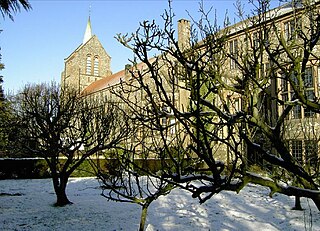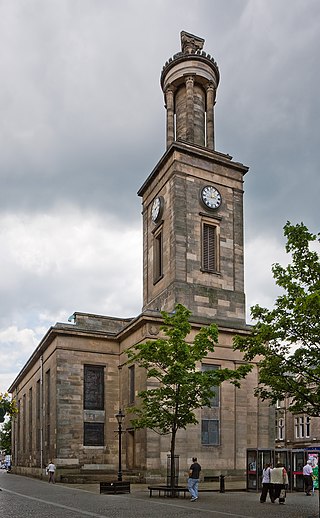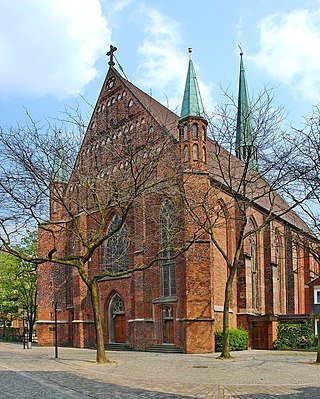
Holyrood Abbey is a ruined abbey of the Canons Regular in Edinburgh, Scotland. The abbey was founded in 1128 by David I of Scotland. During the 15th century, the abbey guesthouse was developed into a royal residence, and after the Scottish Reformation the Palace of Holyroodhouse was expanded further. The abbey church was used as a parish church until the 17th century, and has been ruined since the 18th century. The remaining walls of the abbey lie adjacent to the palace, at the eastern end of Edinburgh's Royal Mile. The site of the abbey is protected as a scheduled monument.

Greyfriars is a Roman Catholic friary and parish located in East Oxford, which until 2008 was also a permanent private hall of the University of Oxford. Situated on the Iffley Road in East Oxford, it was one of the smallest constituent halls of the university. Its status as a permanent private hall (PPH) derived from the fact that it was governed by an outside institution, rather than by the fellows of the University as a constituent college is.

Elgin is a historic city and formerly a royal burgh in Moray, on the North Coast of Scotland. It is the administrative and commercial centre for Moray. The town originated to the south of the River Lossie on the higher ground above the floodplain where the town of Birnie is. There, the church of Birnie Kirk was built in 1140 and serves the community to this day.

John Patrick Crichton-Stuart, 3rd Marquess of Bute, was a Scottish landed aristocrat, industrial magnate, antiquarian, scholar, philanthropist, and architectural patron.

Christ Church Greyfriars, also known as Christ Church Newgate Street, was a church in Newgate Street, opposite St Paul's Cathedral in the City of London. Established as a monastic church in the thirteenth century, it became a parish church after the Dissolution of the Monasteries. Following its destruction in the Great Fire of London of 1666, it was rebuilt to the designs of Sir Christopher Wren. Except for the tower, the church was largely destroyed by bombing during the Second World War. The decision was made not to rebuild the church; the ruins are now a public garden.

Greyfriars Kirk is a parish church of the Church of Scotland, located in the Old Town of Edinburgh, Scotland. It is surrounded by Greyfriars Kirkyard.

Pluscarden Abbey is a Catholic Benedictine monastery in the glen of the Black Burn, six miles southwest of Elgin, Moray, Scotland. It was founded in 1230 by Alexander II for the Valliscaulian Order.

Emerging since the 19th century, there are several Protestant adherent and groups, sometimes organised as religious orders, which strive to adhere to the teachings and spiritual disciplines of Saint Francis of Assisi.
The Society of All Saints Sisters of the Poor is a religious order of sisters in the Anglican Communion. It was founded in 1851 and is active in England and the United States.

In London, the Greyfriars was a Conventual Franciscan friary that existed from 1225 to 1538 on a site at the North-West of the City of London by Newgate in the parish of St Nicholas in the Shambles. It was the second Franciscan religious house to be founded in the country. The establishment included a conventual church that was one of the largest in London; a studium or regional university; and an extensive library of logical and theological texts. It was an important intellectual centre in the early fourteenth century, rivalled only by Oxford University in status. Members of the community at that time included William of Ockham, Walter Chatton and Adam Wodeham. It flourished in the fourteenth and fifteenth century but was dissolved in 1538 at the instigation of Henry VIII as part of the Dissolution of the Monasteries. Christ's Hospital was founded in the old conventual buildings, and the church was rebuilt completely by Sir Christopher Wren as Christ Church Greyfriars after the original church was almost completely destroyed in the Great Fire of London of 1666. The building now standing on the site, designed by Arup Group Limited, is currently occupied by Merrill Lynch.
The Colettine Poor Clares are a reform branch of the Order of St. Clare, founded by Clare of Assisi in Italy in 1211. They follow the interpretation of the Rule of St. Clare established by Saint Colette in 1410, originally a French hermit and member of the Third Order of St. Francis.

The Greyfriars Monastery on the island of Riddarholmen in Stockholm was a monastery for males of the Franciscan Order, in operation from 1270 until the Swedish Reformation of 1527.

Gillis Centre, formerly Gillis College and founded as St Margaret's Convent and School, is a complex of buildings situated close to the city centre of Edinburgh, Scotland. The history of the site can be traced back to the 15th century. The original building housed many literary figures of the eighteenth century, from 1834 it served as a convent and from 1986 to 1993 it was Gillis College, the seminary for the Roman Catholic Church in Scotland. It currently provides offices for the Curia of the Archdiocese of St Andrews and Edinburgh.
The Roman Catholic Church Group, Toodyay is a site on Stirling Terrace in Toodyay, Western Australia, owned by the Catholic Church. This site was registered as Roman Catholic land in November 1861 in the newly proclaimed Avon District town of Newcastle. These buildings were erected here between the early 1860s and 1963:

St. John's Church is a Roman Catholic provost church in Bremen. It was built in the fourteenth century as a Franciscan abbey church and has been a listed monument since 1973.

St Joseph's Convent is a complex of 18th- and 19th-century buildings in Taunton, Somerset, which were primarily used as a Roman Catholic convent, first by the Franciscans, and then Sisters of St. Joseph of Annecy. The buildings were sold out of the Catholic church in 1976, and were redeveloped as residential flats in 2005. The main building is designated by English Heritage as a Grade II* listed building, while the boundary walls on the west side are Grade II listed.

The Friary, formally known as Blessed Agnellus of Pisa Friary, formerly All Saints Convent or St John's Home is a centre of formation for the Franciscan Order of Friars Minor Conventual in Cowley, Oxford, England. The building was constructed in 1873 as the convent of the Anglican Society of All Saints Sisters of the Poor. It is situated between St Mary's Road and Cowley Road, next to St John's Care Home and Helen & Douglas House. The friary and its chapel are Grade II listed buildings.

St Catharine's Convent or St Catharine’s Mercy Centre is a Catholic convent of the Sisters of Mercy and a centre for the homeless in Edinburgh, Scotland. It was built in 1860 and originally designed by David Cousin, with additions made in 1887 and 1892. It is located on the corner of Lauriston Gardens and Lauriston Place in the Lauriston area of Edinburgh. In 1992, it became a Mercy Centre with the mission of helping the local homeless. In 1989, it was designated a category B listed building.
















